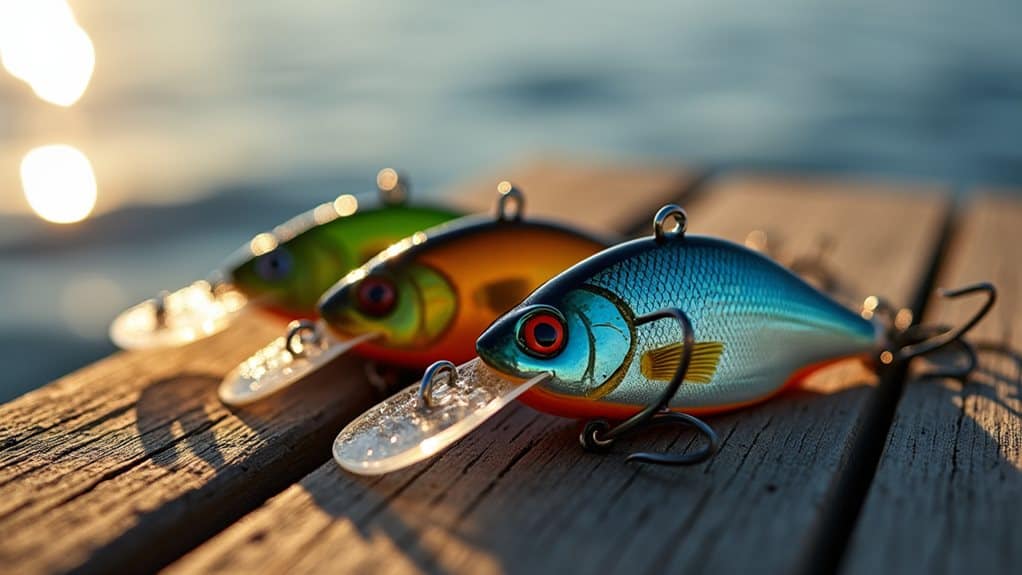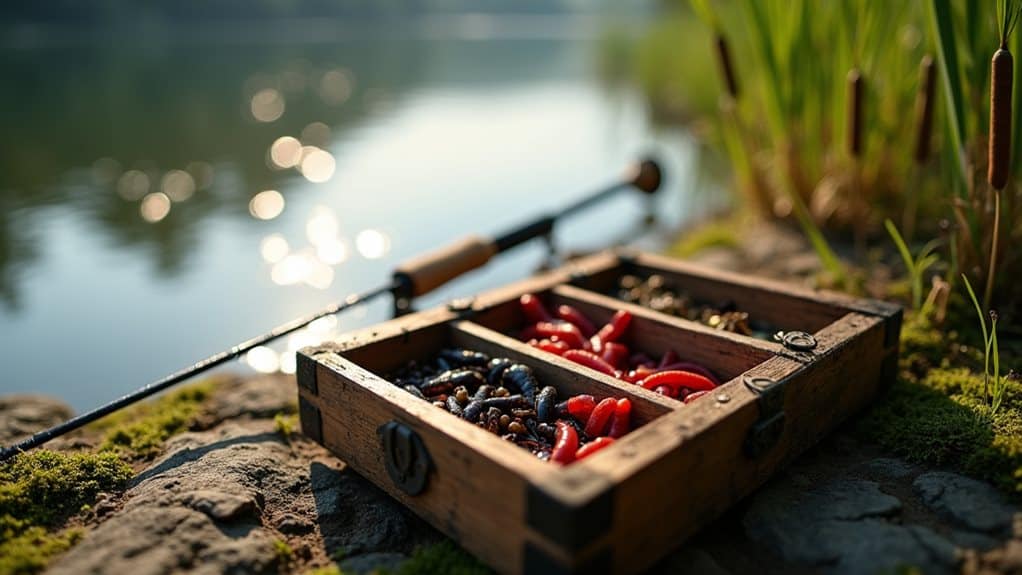You’ll find the most success with live baits like nightcrawlers, earthworms, and crickets, which trigger bluegill’s natural feeding instincts through movement and scent. Small inline spinners with #6-8 blades and mini crankbaits measuring 1-1.5 inches also produce excellent results, especially for larger fish. Fly fishing enthusiasts should try poppers during summer surface feeding or micro wooly buggers at various depths. Match your bait selection to seasonal patterns and water conditions for maximum effectiveness and consistent catches.
TLDR
- Live bait like earthworms, nightcrawlers, crickets, and mealworms are highly effective due to natural movement and scent.
- In-line spinners with #6-#8 blades (1/8-1/4 ounce) like Mepps and Rooster Tails create vibrations that attract bluegill.
- Mini crankbaits (1-1.5 inches) such as Eurotackle Z Cranker and Rebel Bluegill Squarebill trigger aggressive strikes.
- Fly fishing patterns including poppers, micro wooly buggers, and grasshoppers work effectively for surface and subsurface feeding.
- Seasonal presentation matters: slow-sinking baits in spring depths, bobber-suspended worms in summer, bottom presentations in fall.
Live Bait Options That Bluegill Can’t Resist

When targeting bluegill, live bait consistently outperforms artificial lures because these fish are naturally programmed to respond to the movement, scent, and texture of living prey. You’ll find earthworms, nightcrawlers, crickets, and mealworms among the most effective options. These baits trigger feeding instincts through their natural wiggling action, fresh scent, and familiar appearance that bluegill recognize as food. It is important to note that most states require a fishing license for all fishing activities, including catch and release fishing, so be sure to comply with local regulations. Success depends on using small hooks since bluegill have relatively small mouths that can’t accommodate larger tackle.
Top In-Line Spinners for Bluegill Success
While live bait remains the gold standard for bluegill fishing, inline spinners offer an energetic alternative that can trigger aggressive strikes through their combination of flash, vibration, and movement. Mepps Colorado blades produce throbbing vibrations, while Rooster Tails feature feathered hackles for added flash. Additionally, using small boat fish finders can help locate bluegill by detecting their depth and movement. Choose #6-#8 blade sizes with 1/8 to 1/4 ounce weights for ideal bluegill targeting. Use a slow retrieval to mimic the natural movement that bluegills expect from their prey.
Small Crankbaits and Hard Baits for Trophy Fish

Small crankbaits represent a game-changing approach to targeting trophy bluegill, as these tiny hard baits trigger aggressive strikes that traditional soft baits often can’t match.
You’ll find that mini crankbaits in the 1-1.5 inch range, like the Eurotackle Z Cranker and Yo-Zuri Snap Bean, produce that tight wobble and realistic action that turns cautious big bluegill into aggressive predators.
Mastering the right retrieval techniques—including strategic pauses and subtle twitches—will help you release this exciting, bass-like fishing experience while targeting panfish. Additionally, kayak fishing provides an ideal platform for using these baits, as it allows for stealthy approaches to bluegill hotspots.
Best Small Crankbaits
Trophy bluegill require a more sophisticated approach than your typical panfish outing, and small crankbaits offer the precision and appeal necessary to entice these wary, larger specimens.
The Rebel Bluegill Squarebill combines realistic panfish profiles with internal rattles, while Rapala’s DT-4 Bluegill delivers excellent shape and lifelike coloration.
Megabass Super Z1 excels in shallow water targeting trophy-sized fish effectively.
Effective Retrieval Techniques
Having the right lure is only half the battle when targeting trophy bluegill with small crankbaits and hard baits.
You’ll need to dominate specific retrieval techniques to trigger strikes. Use a slow and steady retrieve for tiny jerkbaits and lipless crankbaits, while employing a bump-and-drag method to contact submerged structures where trophy bluegill often hide.
Fly Fishing Patterns That Attract Bluegill
When targeting bluegill with a fly rod, you’ll find that these panfish respond enthusiastically to patterns that mimic their natural prey, from surface insects to small aquatic creatures.
Panfish poppers excel during summer surface feeding, while micro wooly buggers work effectively at various depths.
Grasshoppers attract fish near vegetation, and hare’s ear nymphs imitate subsurface aquatic insects perfectly. Additionally, understanding the seasonal patterns of bluegill behavior can further enhance your fly fishing success.
Essential Fishing Techniques for Better Results

Beyond selecting the right fly patterns, perfecting proven fishing strategies will dramatically improve your bluegill success rate on the water.
Use bobber rigging to suspend bait at ideal depths, then fan cast around likely holding spots.
Try vertical fishing near deep docks, flip lures close to structure like fallen trees, and focus your efforts where you’ve already received multiple bites.
Alternative Live Baits Worth Trying
While nightcrawlers and red worms remain the go-to choices for most bluegill anglers, expanding your live bait arsenal can considerably enhance your success on challenging days when fish seem finicky.
Crickets excel in shallow water situations, while minnows attract larger bluegills in deeper areas.
Mealworms, waxworms, and maggots offer convenient alternatives that require minimal maintenance yet provide excellent results.
Seasonal Bait Selection Strategies

Four distinct seasons bring four distinct opportunities to refine your bluegill bait selection, and understanding these seasonal patterns can dramatically improve your catch rates throughout the year.
Early spring demands slow-sinking nightcrawlers in deeper water, while summer calls for bobber-suspended worms at 1-3 feet.
Fall shifts require bottom-focused presentations using earthworms and crickets to match their natural diet.
Proper Bait Presentation Methods
Once you’ve selected the right bait for the season, your presentation technique becomes the critical factor that separates successful anglers from those who return empty-handed.
Use small bobbers set 1-3 feet deep for ideal results. Live worms and crickets work exceptionally well with light tackle.
For artificial options, try small, bright-colored jigs with grub tails using gentle jerking motions.
Tackle Setup for Maximum Effectiveness

Having the right presentation technique means nothing without proper tackle to support it, and your equipment choices can make or break your bluegill fishing success.
Use a light 6-foot rod with 6-pound monofilament line paired with size 6-10 hooks.
Position slip bobbers at proper depths, balance them with split shot weights, and choose beak-style hooks to prevent deep hooking while maintaining ideal sensitivity.
Location-Based Bait Recommendations
While your tackle setup provides the foundation for success, selecting the right bait for specific fishing locations dramatically increases your chances of landing more bluegill.
Different environments require targeted approaches—shallow vegetation calls for earthworms and crickets, rocky areas respond to small jigs and spinners, while docks favor grasshoppers and micro jigs for best results.
Final Note
You’ve now got an extensive toolkit for catching bluegill consistently. Remember, worms and crickets remain your most reliable live baits, while small spinners and poppers excel during active feeding periods. Match your bait selection to the season and water conditions, present it naturally near cover, and you’ll increase your success dramatically. Don’t overthink it—bluegill aren’t overly selective, so confidence in your chosen bait often makes the difference between a good day and a great one.




